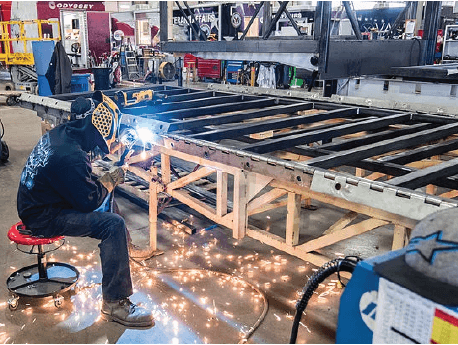Expert welding repair tips from Belgrade Welding professionals
Wiki Article
All Regarding Welding: Secret Insights Into Techniques and Best Practices for Success
Welding includes a selection of strategies, each suited for details materials and applications. Comprehending these approaches, such as GMAW, SMAW, and TIG, is crucial for attaining perfect outcomes. Furthermore, the best equipment and safety and security techniques can not be ignored. As prep work and troubleshooting play crucial functions in the welding procedure, mastering these components can substantially boost the high quality of the last item. What are the key variables that assure an effective weld?Comprehending Different Welding Strategies
Welding techniques encompass a selection of techniques, each matched to particular applications and materials. Among one of the most typical strategies are Gas Steel Arc Welding (GMAW), Secured Metal Arc Welding (SMAW), and Tungsten Inert Gas Welding (TIG) GMAW, also understood as MIG welding, is preferred for its rate and flexibility, making it excellent for thin materials. SMAW, or stick welding, is favored for its simpleness and effectiveness in outdoor atmospheres, especially with thicker metals. TIG welding provides precision and control, making it ideal for intricate work and non-ferrous metals (Montana Mobile Welding and Repair Belgrade Fabrication). Each technique has its unique benefits and considerations, enabling welders to select the most effective method based on the task's requirements, product type, and wanted results. Comprehending these strategies is vital for effective weldingImportant Welding Tools and Tools
While numerous welding methods require particular skills, the best devices and devices are just as important for attaining quality outcomes. Necessary welding equipment consists of welding devices, which differ relying on the technique-- such as MIG, TIG, or stick welding. Safety equipment, including headgears, aprons, and handwear covers, assurances safety and security and convenience throughout the process. On top of that, clamps and components aid protect products in place, ensuring precision in welds. Consumables like welding poles, cord, and securing gas are also crucial elements that affect the quality of the weld. Moreover, tools such as grinders and cutters help with surface prep work and post-weld ending up, contributing to an expert outcome. Spending in high-grade tools eventually enhances the performance and performance of welding projects.Safety And Security Practices in Welding
Proper security methods are vital in the welding sector to secure employees from possible dangers. Welders must put on appropriate individual protective equipment (PPE), including headgears with correct shading, handwear covers, and flame-resistant apparel. Sufficient air flow is crucial to reduce direct exposure to unsafe fumes and gases produced throughout the welding process. Additionally, workers need to be educated in the proper handling of welding equipment to avoid accidents. Fire security measures, such as keeping flammable products far from the welding area and having fire extinguishers readily offered, are required. Regular inspections of tools and work spaces can aid recognize prospective risks before they bring about crashes. By adhering to these security practices, welders can create a more secure working environment and minimize threats related to their profession.Readying Materials for Welding
Preparing materials for welding is an important action that greatly influences the high quality and integrity of the final product (Montana Mobile Welding and Repair Belgrade Fabrication). Appropriate preparation entails cleaning the surfaces to eliminate pollutants such as rust, dust, and oil, which can jeopardize the weld. Techniques such as grinding, fining sand, or utilizing solvents are typically used to accomplish a clean surface. Furthermore, guaranteeing that the materials mesh comfortably is vital; gaps can portable welder cause weak welds. It's likewise crucial to consider the placement and positioning of the elements, as this will certainly influence the convenience of welding and the final outcome. Ultimately, picking the ideal filler material and guaranteeing compatibility with the base metals is essential for achieving strong, long lasting weldsTips for Getting High-Quality Welds
Accomplishing top notch welds needs interest to information and adherence to ideal techniques throughout the welding procedure. Correct joint preparation is crucial, making sure surfaces are clean and free from pollutants. Picking the appropriate filler material and welding strategy based on the base steels is critical for ideal bonding. Maintaining regular travel rate and angle while welding can prevent problems and promote harmony. In addition, regulating warmth input is vital; excessive heat can bring about bending and weakened joints. If needed, on a regular basis evaluating the welds throughout the process allows for immediate modifications. Utilizing appropriate post-weld treatments, such as cleansing and stress and anxiety alleviation, can improve the toughness and integrity of the weld, inevitably making certain an effective end result.Troubleshooting Common Welding Issues
Welding typically presents difficulties that can influence the quality and integrity of the end product. Common concerns such as porosity, irregular weld grains, and getting too hot can occur, each requiring details fixing methods. Comprehending these problems is important for welders to improve their skills and accomplish perfect results.Porosity Problems Described
Although porosity can commonly be ignored, it remains a vital concern in welding that can compromise the stability of a finished item. Porosity refers to the visibility of small gas pockets within the weld grain, which can damage the joint and lead to early failure. This problem usually occurs from contaminants, wetness, or incorrect shielding gas coverage throughout the welding process. To minimize porosity, welders must validate that the base products are completely dry and tidy, use suitable shielding gases, and keep constant welding specifications. Regularly evaluating the devices and environment can likewise help determine possible issues prior to they materialize in the weld. Resolving porosity properly is essential for accomplishing solid, resilient welds that meet high quality criteria.
Irregular Weld Beans
Irregular weld beads can considerably influence the high quality and strength of a finished item. Different factors add to this concern, including inappropriate travel rate, wrong amperage settings, and inconsistent electrode angles. When the welder moves as well quickly, a grain may show up narrow and do not have penetration, while relocating also slowly can create too much buildup. Additionally, utilizing the incorrect amperage can cause either undercutting or extreme spatter, both of which concession weld integrity. The welder's strategy, such as irregular torch activity, can likewise lead to unequal grain appearance. To alleviate these issues, welders ought to concentrate on maintaining consistent, controlled movements and making certain correct tools setups to attain harmony in their welds. Uniformity is essential to accomplishing trusted and solid welds.Overheating and Warping Issues
Extreme warm during the welding procedure can lead to significant overheating and deforming issues, impacting the architectural stability of the work surface. These troubles usually manifest as distortion, which can endanger positioning and fit-up, making further setting up challenging. Variables adding to overheating include the option of welding criteria, such as voltage and travel rate, as well as the kind of material being welded. To minimize these concerns, welders ought to preserve constant travel speed and ideal heat input while checking the work surface temperature. In addition, pre-heating or post-weld warm therapy can help alleviate stress and anxieties created by quick cooling - Belgrade Welding. Normal examination and adherence to ideal practices are crucial in preventing overheating and making sure the long life and dependability of bonded frameworksOften Asked Concerns
What Are the Job Opportunities in the Welding Industry?
The welding industry provides varied job opportunities, including settings as welders, instructors, examiners, and engineers. Professionals can operate in manufacturing, building, aerospace, and automotive sectors, profiting from strong demand and competitive incomes in numerous duties.Just How Can I Boost My Welding Speed Without Giving Up Quality?
To boost welding rate without sacrificing top quality, one ought to practice efficient strategies, maintain tools, optimize settings, and improve hand-eye sychronisation. Routine training and looking for comments can likewise significantly contribute to accomplishing much faster, high-quality welds.What Certifications Are Available for Welders?
Various accreditations exist for welders, including those from the American Welding Culture (AWS), the National Facility for Building And Construction Education and Study (NCCER), and different industry-specific organizations. These qualifications enhance employability and demonstrate skill effectiveness.How Does Welding Influence the Features of Metals?
Welding affects the homes of steels by modifying their microstructure, which can cause adjustments in hardness, ductility, and toughness. Heat input and cooling rates during the process greatly impact these material attributes.Can I Bonded Dissimilar Metals With Each Other?

Report this wiki page